If you would like to know how to grip a semi-automatic handgun so that you can shoot as fast and accurately as possible, then this short article will show you how.
Seems simple right?
Pick the gun up and start shooting it!
In reality, if you’ve ever attempted to shoot a handgun fast AND accurately, then you probably have run into some issues …
If you’re a right handed shooter, you probably miss your target to the low left (if you’re left handed then it’s low right)
You can’t seem to keep a good hold on the gun after multiple shots, and you have to keep re-doing your grip, and your accuracy gets worse the more you shoot it. Or better. Either way, you’re not consistent.
All these can be signs of a poor grip on your handgun.
Let me show you how to get the best handgun grip possible …
What Should Your Handgun Grip Do?
There are many things a proper handgun grip should help you do …
One, it should be consistent, so that every time you pick the handgun up and draw it you are building a natural index on target.
Two, you should be gripping the handgun in a way that allows you to have the absolute best trigger control possible so that you are as accurate as possible.
Three, you should be gripping the handgun in a way so that your grip is solid on the gun (there is no chance of dropping the gun, or it being taken away from you) and so that you have maximum recoil control.
Now, let’s define something …
What is Recoil Control?
When we are talking about recoil control, you have to understand this one key factor: The gun is going to recoil and there’s nothing you can do to stop it.
So do not try to keep the gun from “jumping” or recoiling in your hand because it’s going to do that. It’s a little mechanical device that’s literally containing a small explosion in your hands so it’s going to recoil.
The key is recoil “control”. That means having a good enough grip on the handgun that you …
1.) Minimize the time the sights move off the target and
2.) Your grip allows the sights to return to the target at more or less the same spot they were because of a consistent grip
What Are The Elements of a Proper Handgun Grip?
There are a few things that make for a good grip, and believe it or not, a lot of it is personal to you …
In other words, you’ll have to figure out for yourself how to make it work.
One, you want the trigger to be pressed straight to the rear without disturbing the sights. With your “primary” hand, this is the most important part. You need to grip the gun in such a way that you can press the trigger straight to the rear without disturbing the sights.
The ONLY way to discover the primary/strong hand grip that allows you to do this is to practice it in dry fire.
You need to do a version of the “Wall Drill” where you essentially take a (triple-checked) unloaded gun and aim in — with the barrel only 1 inch away — from a blank wall and align your sights. Then you press the trigger. If your sights do NOT move then you are doing it correctly. If your sights move, try again.
This takes practice to find the ideal grip position of your primary hand on your particular handgun because 1) everyone has different sized hands and 2) many handguns have different sized stocks (the correct name for the part of the pistol your hand grips).
For example, a lot of people will tell you that a proper primary hand grip on the gun would have the backstrap in line with the bones of the forearm as in the picture below:

While that would be “ideal” it is in no way necessary. In fact, for anyone with small hands I doubt you can grip a modern semi-automatic handgun in that way and be able to press the trigger straight to the rear.
For example, here is a picture of my own primary hand grip where I have to grip the handgun off the line of center of my forearm to be able to press the trigger to the rear. I discovered this through hundreds of dry fire repetitions. This is the picture I immediately took in my hotel room after discovering the right hand positioning so I would not forget it:
The fact of the matter is that pressing the trigger straight to the rear without disturbing the sights is the most important part of shooting your handgun accurately — while all the other components of proper handgun grip can be negotiated — this is the primary component that cannot be violated.
I’m emphasizing this point, because it was a big hurdle for me to overcome when I first started learning about shooting a handgun seriously.
All the “experts” say that having the gun sit in a straight line with your forearm is the “right” way but it’s simply not true.
Rob Leatham — possibly the most successful professional competition shooter of all time AKA “The Great One” — says the same thing:
“The angle the gun sits in relation to your arm is not that important. Being able to place your finger properly on the trigger is.
“Don’t try to align the barrel of the pistol with your arm. For me to reach most triggers, because of my short fingers, the gun actually points a little to the right or outside of the line of my forearm.”
After finding the right grip for your primary hand in relation to your forearm so that you can press the trigger straight to the rear without disturbing the sights, here are the other important points.
Thumbs Up And As High On The Gun As Possible
If there is any space between the top backstrap of the handgun and your primary hand then you are doing it wrong.
You want to jam the wedge of your thumb of your primary hand UP into the backstrap of the gun. This area should be as tight as possible and you should definitely not be able to see any light through this area.
This is of critical important because it directly relates to recoil control.
Secondly, your primary hand thumb should be high up in the air. Think “thumbs up” because you’re doing it right.
This will actually help you get a tighter wedge between the backstrap and your hand because the upward pressure of your thumb will drive your hand into the handgun.
The other important reason you keep that primary hand thumb high is because you are making space on the handgun to insert your support hand.
The key here is that if your primary hand thumb is not high, then it will keep your support hand from having the maximum amount of contact with the stock of the handgun — reducing your control …
… But when the thumb is high, your hands fit together like a puzzle piece.
In the video below, a Grandmaster shooter shows you many of the elements of building the common “thumbs forward” grip:
Your Support Hand Should Be As High And Back On The Gun As Possible
Much like the firing hand, the support hand should be as high on the stock of the handgun as possible … and … you should actually try to get some of your hand behind the grip if possible.
Then, either keeping the thumbs forward or high (depending on the size of your hands) you will lock your wrists, while trying to keep the maximum amount of your support hand palm behind the gun as possible.
This part is key and was the source of a lot of my problems because I kept hearing how you’re supposed to have your thumb and/or support hand angled forward for a “proper grip” but much like the position of your primary hand wrapping around the stock of the handgun — it has to do with your individual hand and finger size and how it interacts with the handgun you’re shooting.
If you have big hands and long fingers you’ll be able to keep your entire support hand behind the gun, while at the same time angling your thumbs forward.
If you have smaller hands and shorter fingers like me, you’ll find your thumbs pointing more upright to keep more of your hand behind the gun.
Again, you’ll have to experiment.
The key is to get as much of your support hand on the weapon as possible for the maximum amount of friction and as behind the weapon as possible to control recoil.
In the video below, Mike Seeklander (also a world champion shooter), shows some of the key points that allow him to get locked wrists and as much of his hands behind the gun as possible:
Finally, Squeeze As Hard As Possible, Especially When Dry Firing
This goes against what you might have heard for bullseye shooting or whatever, but to shoot fast and accurately (like you need to use your pistol defensively) — you need to grip the handgun as hard as possible.
Again, to quote “The Great One” Rob Leatham …
“Most shooters are told to relax and not grip the pistol tightly. This is ok if all you will ever fire is a .22, but even that gun is going to kick. You need to hold firmly.
A new shooter or beginner may have better things on which to concentrate, but even they need have a strong enough grasp to completely control their gun. If you’re an experienced shooter, you can just go ahead and ignore the “relax” part all together.
… Gripping properly will not just happen. I have to address this issue with many experienced, top-notch shooters. Most think it will just come with practice, but it doesn’t unless you think about it. One area that dry fire can really help is maintaining a tight grip while pulling the trigger.
It’s easy to pick up bad habits from dry firing with no live fire to support the techniques being learned. If you never have to deal with effects of the gun firing, muzzle flip and recoil, you will never learn how to control them.
In my three decades of training every level of shooter, I have seen only a handful that held on too tightly. On the flip side, I’ve seen hundreds that hold on too loosely.”
Forget the 60-80% grip pressure this way, or that way B.S. that you often hear. The correct amount of grip pressure is to grip the handgun as hard as you can, until you’re shaking, then slightly back off that, and try to maintain that pressure — consistently — until you’re done shooting.
That makes it simple.
In short, we’re trying to grip the gun as hard as we can, and keep the pressure steady, without trembling from the exertion.
An important point, is that the stronger your hands and your physical grip is, the more pressure you can exert on the gun and not shake.
For instance, if you have 300lbs of crushing power in your hands — and you only use 50% of your hand strength — you can exert 150lbs of pressure to your recoil control without over-exerting yourself and causing your hands to shake.
Thus, it pays to have strong hands. You can build this strength from both 1) dry firing as much as possible while practicing gripping the gun as hard as possible and 2) from specific hand strength training exercises such as the Captain-of-Crush grip trainers.
Bob Vogel, another world class shooter, has a completely unique grip in the world of pistol shooting (as far as I’ve seen) but I’ve heard from multiple sources how impressed they are with how hard he grips his handgun.
Keep Your Elbows Bent As Well
Another key is that while it may seem like you have more control over the handgun by locking your elbows, you should actually keep a slight bend in your elbows.
There are more than a few reasons why this is so …
1.) Your elbows will act like natural “shock absorbers” to help control recoil …
2.) Most importantly, I’ve found, it almost forces you to lock your wrists in order to keep the sights aligned with your eyes …
3.) A slight bend in the elbows helps to avoid driving the first shot low when you’re in a hurry to get the first shot out of the holster.
One more thing you can experiment with in regards to your elbows is turning them slightly up, to help create inward crushing pressure on your grip.
In Summary …
Your handgun grip is one of the most important factors in how fast and accurately you can shoot a handgun — both critical in a defensive shooting situation.
Some things you’ll have to figure out by trial and error to make them work with your particular sized hands and the gun you’re shooting.
Many of the principles though — getting your hands as high on the gun as possible, locking the wrists, and gripping as hard as possible — are universal and will help you no matter how you grip the handgun.
Grab your handgun, unload it and after triple-checking to make sure it’s empty and start practicing building a better grip today.




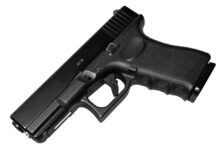
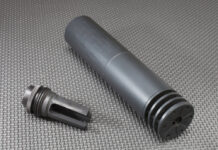
![Are Compensators Worth It? [Video]](https://preparedgunowners.com/wp-content/uploads/2025/07/Depositphotos_815431992_S-218x150.jpg)


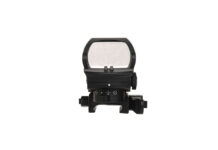
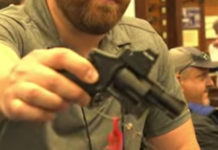
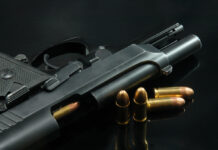

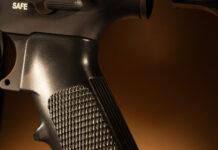
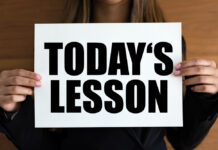

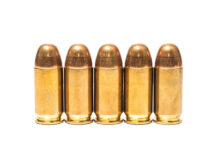
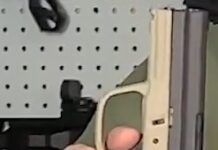
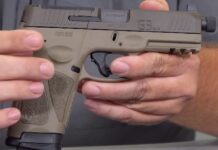

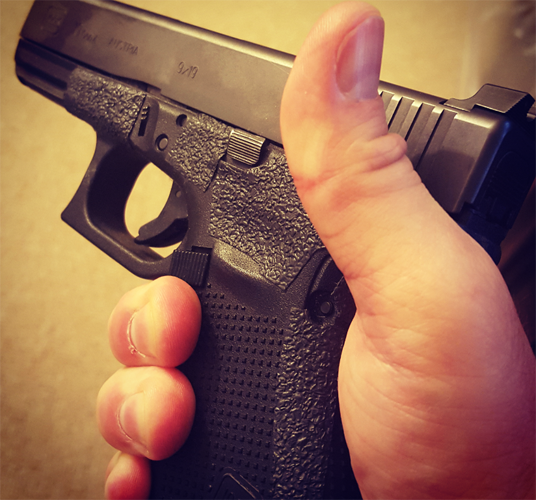

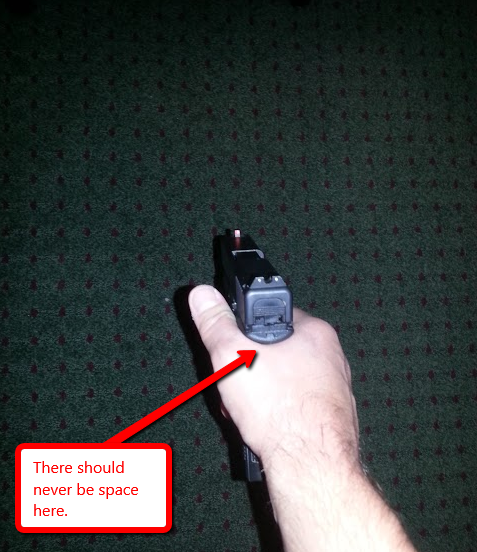






![Are Compensators Worth It? [Video]](https://preparedgunowners.com/wp-content/uploads/2025/07/Depositphotos_815431992_S-100x70.jpg)


![Optic Ready vs Milled slides? [Video]](https://preparedgunowners.com/wp-content/uploads/2024/02/image-3-100x70.png)
![[Checklist] What Gear You Need To Take Pistol, Rifle & Shotgun Training Courses [Video]](https://preparedgunowners.com/wp-content/uploads/2023/07/Depositphotos_275087632_L-100x70.jpg)
![What is in Carter’s 2023 EDC? [Video]](https://preparedgunowners.com/wp-content/uploads/2023/07/Depositphotos_146856137_L-100x70.jpg)
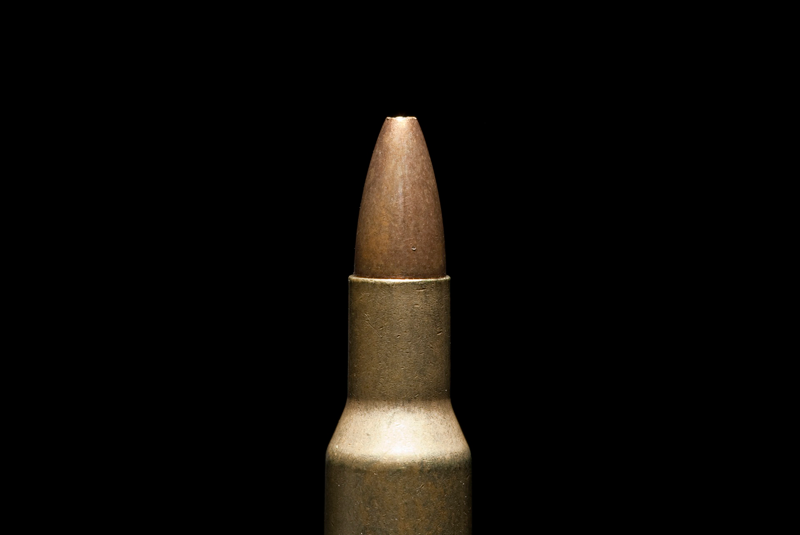
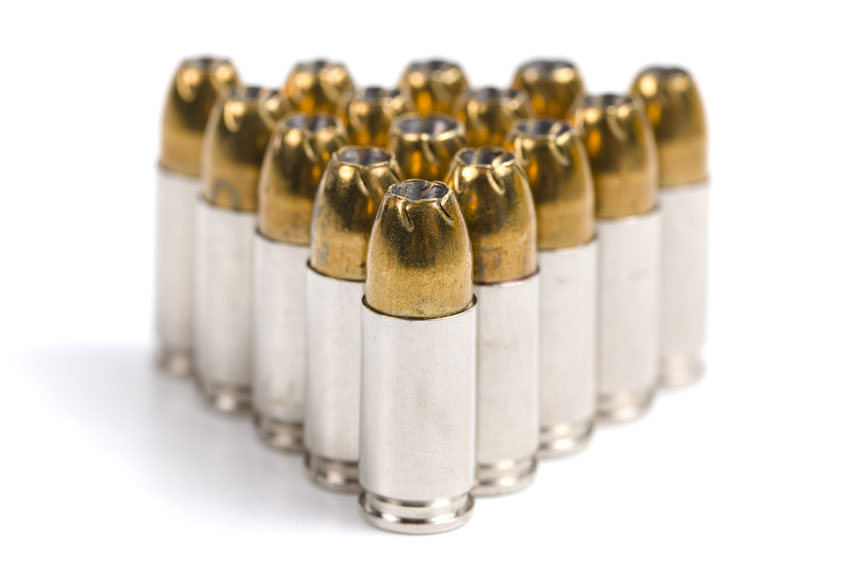
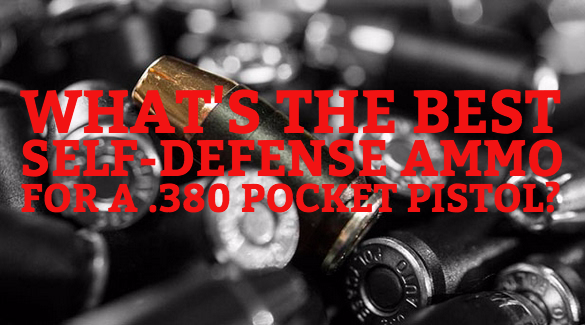
Nice article. Have shot a1911a1 since I was teen (now 70) , and have only used light three finger grip. Never considered someone trying to take it away, or even allowing them to get that close. I am spot on though when I pull the trigger.
LOOK OUT GROUSE!
Thank you, thank you, thank you! You shared some really interesting and helpful info without requiring me to listen to a long, long, long, and often boring sales pitch. Yes, I’m a customer off and on, but getting a freebie that’s worthwhile is appreciated. Thank you, again! Jim
One expert tells us to keep our arms straight and another says to bend the elbows. Both are successful competitors. You just have to find out what works the best for you. Whether we are shooting an arrow,, hitting a golf ball or shooting a gun the most important factor is to have consistently good technique. It’s easy to be consistently inconsistent.
Caleb great article
When we used to train Interdiction teams to shoot we used to start with them placing the middle of the index finger distal joint pad (the last join under the finger nail) exactly the middle of the pad on the middle of the trigger so that the trigger sits neither too far out or too far back on the last joint
Then we would wrap their hand around the stock (grip in most people’s mind) and then make sure the thumb was as high as possible
Starting with the index finger and warping the whole hand around the gun allows the person to determine how much extra or less backstrap they need to add or remove to make the proper fit for their hand. NOT every off-the-shelf grip will work for everyone it simply can’t it is an “average size” model
Then as you stated we made them jam the now proper grip and the web between the thumb and index into the beavertail. That is essential for proper pistol mechanics. Forget about accuracy and speed if the recoil is not used to properly compress the internal springs the next round will not properly advance. You will get a failure to load situation. If you video the majority of failed rounds ones that were caused by not a failure to remove the spent but a failure to load the next it is because the wrist was not locked or the tip-lift drop the gun into the space in the web which shouldn’t have been there to begin with. That slight upward motion driving the pistol deep into the web is more then enough to alter the mechanics unless you are shooting high velo ammo.
Great article good to see going back to the very basics since the fundamentals are the issue with most shooters since most never really trained they learned from Pa or Bro or took one or two “classes” but the issues magnify over years of shooting without supervision to constantly correct them
Dr D
I like your way of finding the right grip by starting with the trigger — that’s really smart … gonna try that soon.
It works great start with the finger maybe even having someone else holding the gun and then wrap your finger around it then thumb web then the rest of the fingers and you will likely see that depending on the size of your hand and the size of the stock you might be wrapped too far around or not enough and that is where altering the size of the stock comes in
You don’t need a custom grip like Glock Gen 4 has either you can buy really inexpensive sleeves to put on the grip or I LOVE this stuff called RAT grip it is basically a special sheet of material that you heat in water or a heat supply and then wrap it around the stock then grab the gun as you SHOULD be and let it cool down. It can permanent of not depending on choice
The MOST important way to get an accurate shot is to start with a proper grip. You can’t build a quality house on a lousy foundation same for a great accurate gun shot. You start with grip and build from there
Dr D
IF YOU ARE A NOVIS, PAY ATTENTION TO WHAT YOU NEED TO LEARN OF WHAT THE ART OF WEAPONRY WILL PAY OF ON SOME UNGIVEN DAY …
AS A WEAPONS INSTRUCTOR IN ALL INFANTRY WEAPONS AND ALSO A MEMBER ON THE 7TH ARMY RIFLE TEAM FIRING M-1 GARAND 30 CALS…BOOBY TRAPS AND MORE!!
SO, EVEN IF YOU WERE THERE IN THE FIGHT, THERE WILL ALWAYS BE SOME NEEDED ATTITUDE TO GET THRU THE DAY..
4 finger handle grip is my favorite with my thumb on the inside ledge
What about my trigger finger? It on my “cupping grip.” (The forefinger is the trigger finger
Comments are closed.